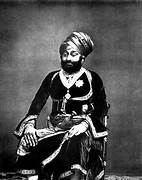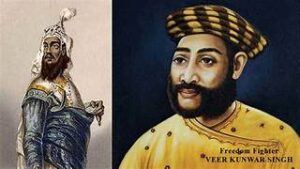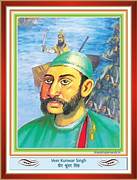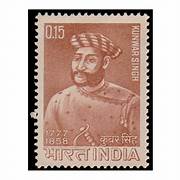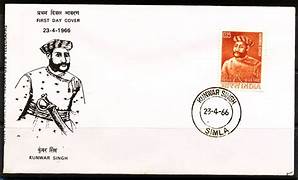Babu Veer Kunwar Singh (1777-1858) was a prominent leader in the Indian Rebellion of 1857 against British colonial rule. Born in Bihar, he played a crucial role in the uprising, displaying exceptional courage and military acumen. Kunwar Singh, despite his advanced age, led his forces with valor and skill. He is remembered for his daring exploits, particularly the Siege of Arrah, where he fought fiercely against the British forces. Kunwar Singh’s legacy endures as a symbol of resistance and patriotism, with his contributions acknowledged in India’s struggle for independence.
Babu Veer Kunwar Singh, also known as Kunwar Singh, was a prominent leader during the Indian Rebellion of 1857. Also known as the Indian Mutiny or the First War of Independence. He was born in 1777 in Jagdishpur, Bihar, India, and belonged to a Rajput zamindar (landowner) family.
Kunwar Singh played a significant role in the uprising against the British East India Company. Despite his age (he was in his 80s during the uprising), he displayed remarkable courage and military acumen. His leadership was crucial in uniting the local rulers and soldiers against the British.
One of the notable incidents in Kunwar Singh’s life was the Siege of Arrah in 1857. Kunwar Singh, along with his forces, successfully defended the town of Arrah against the British forces. His heroic resistance became a symbol of the Indian resistance against British colonial rule.
Kunwar Singh continued to battle the British, and his guerrilla tactics were successful in holding the British army at bay. Unfortunately, he succumbed to injuries sustained in battle and died on May 26, 1858.
During a watershed moment in Indian history, Babu Veer Kunwar Singh emerged as a valiant liberator who opposed British slavery. The records of the Indian freedom movement honour his legacy.
Babu Veer Kunwar Singh Early Life:
Babu Veer Kunwar Singh, a prominent figure in the Indian Rebellion of 1857, was born on November 1777 in Jagdishpur, Bihar, India. Kunwar Singh grew up in a Rajput family that valued principles like honour, courage, and loyalty. Early interests in horseback riding and martial arts would prove to be crucial to his success as a military commander.
Growing up in a tumultuous period in Indian history, Kunwar Singh witnessed the social and political changes brought about by British colonial rule. His early years imparted a firsthand account on foreign dominance and a drive to combat the injustices done on his people.
Early in life, Kunwar Singh developed a strong sense of duty to his family and community. He inherited the title of “Raja” and the estate of Jagdishpur, and he took on the responsibility of maintaining law and order in the region. His leadership qualities and sense of justice earned him the respect of the local populace.
As the grievances against the British East India Company intensified, Kunwar Singh became increasingly involved in the resistance movement. After being unsuccessful in his early attempts to find a truce, he became more involved in the struggle against colonial oppression. The events of Kunwar Singh’s early life paved the way for his eventual emergence as a crucial player in the movement for Indian independence.
Babu Veer Kunwar Singh Education:
Babu Veer Kunwar Singh, a prominent leader in the Indian Rebellion of 1857, was born in 1782 in a Rajput family in Jagdishpur, Bihar, India. Although his academic background is not well recorded, he comes from a martial-arts-oriented household.
Early military training helped Veer Kunwar Singh acquire the fighting prowess and bravery inherited from his Rajput ancestry. Early military experiences and exposure to the sociopolitical milieu that characterised early 19th-century India are likely to have had a significant impact on his beliefs and leadership ability.
The Indian Rebellion of 1857, also known as the Sepoy Mutiny or the First War of Independence, marked a turning point in Veer Kunwar Singh’s life. At the age of 75, he emerged as a key leader in the struggle against British colonial rule. Despite his advanced age, he displayed remarkable military acumen and resilience in leading his forces against the British.
Veer Kunwar Singh’s dedication to the cause of independence and ability to mobilise people behind him demonstrated his leadership abilities. Though his exact educational background is not well known, his deeds and historical significance demonstrate the value of real-world experience, practical understanding, and a strong sense of national pride.
To summarise, although there is a lack of comprehensive documentation regarding Babu Veer Kunwar Singh’s formal education, his life and contributions highlight the importance of pragmatic abilities, bravery, and a strong dedication to the cause of freedom during a pivotal juncture in Indian history.
Babu Veer Kunwar Singh Injury:
During the Indian Rebellion against British colonial rule in 1857, renowned Indian historian Babu Veer Kunwar Singh suffered severe injuries. Kunwar Singh, an influential leader from Bihar, played a crucial role in the rebellion, despite his advancing age.
A bullet struck Kunwar Singh in April 1858 at Jagdishpur, during a battle against the British army. Despite being hurt, he fought bravely. The worst injury was to his left wrist. His resilience and determination inspired his followers and soldiers, symbolizing his unwavering commitment to the cause of Indian independence.
Despite his injury, Kunwar Singh remained an active participant in the rebellion until his eventual passing on May 26, 1858, leaving behind a legacy of bravery and dedication to the fight against colonial rule. His courage in the face of adversity remains a celebrated part of India’s history of resistance against British rule.
Role in the Indian Rebellion of 1857:
Babu Veer Kunwar Singh was a prominent and valiant figure in the Indian Rebellion of 1857, also known as the Sepoy Mutiny or the First War of Independence. Renowned for his military career, Kunwar Singh was born into a Rajput family of royalty in Jagdishpur, Bihar, in 1777. Kunwar Singh rose to prominence in the insurgency against the British East India Company in 1857.
Kunwar Singh’s role in the rebellion was particularly significant in the context of Northern India. At eighty years old, he led his army in multiple fights against the British, displaying incredible bravery and strategic insight. His leadership was crucial in inspiring and uniting various factions of rebels. Notably, he managed to capture the strategic city of Arrah and held it for a considerable period, effectively challenging British authority in the region.
Babu Veer Kunwar Singh’s tenacity and resolve served as a model of resistance for countless Indians struggling against British persecution. Despite facing significant challenges, including age and health issues, Kunwar Singh continued his struggle until his death in 1858. Regarded as a national hero, he valiantly fought for independence at a critical juncture in the nation’s history, and his influence remains a vital component of India’s history of defiance against colonial rule.
Rebellion Involvement:
Babu Veer Kunwar Singh was a significant character in the Indian Rebellion of 1857, known for his bravery and leadership. As a zamindar (landowner) from Bihar’s Jagdishpur estate, he was nearly eighty years old when he joined the uprising. Despite his age, Kunwar Singh demonstrated remarkable energy and tactical acumen.
Kunwar Singh’s involvement in the rebellion was driven by a deep sense of patriotism and resistance against British colonial rule. He successfully organized local forces and utilized guerrilla warfare tactics to challenge the British. His strategic prowess was evident in several battles where he inflicted significant damage on British forces.
One of his notable achievements was the recapture of Azamgarh in 1858. Although the British eventually regained control, Kunwar Singh’s efforts inspired many and demonstrated the potential for organized resistance against colonial powers. His leadership not only galvanized local support but also left a lasting legacy in the struggle for India’s independence.
Despite suffering a severe injury during the conflict, where he famously amputated his own arm to prevent infection from a bullet wound, Kunwar Singh continued to fight. His determination and sacrifice made him a symbol of bravery and resistance, and his contributions are remembered with great respect in Indian history.
Babu Veer Kunwar Singh Honors:
Babu Veer Kunwar Singh was a significant leader and key figure in India’s 1857 rebellion against British colonial power. Born in 1782 in Jagdishpur, Bihar, he belonged to a royal Rajput family. Veer Kunwar Singh displayed exceptional courage, leadership, and strategic acumen during the uprising.
His 80-year-old leadership of the Indian forces, displaying unshakable resolve and patriotism, was one of his most amazing accomplishments. He was vital at the Siege of Arrah, where he held off British forces for several weeks, showing his military prowess. His commitment to the cause of Indian independence earned him the title of “Veer” (meaning brave), and he became a symbol of resistance against British oppression.
Babu Veer Kunwar Singh’s legacy is celebrated for his sacrifice, valor, and dedication to the struggle for freedom. In the annals of India’s struggle for independence, he continues to be regarded with great reverence for his noble achievements. The plaudits and honours conferred upon him reflect the nation’s appreciation for his unselfish devotion in the cause of liberty.
Role in the 1857 Uprising:
Babu Veer Kunwar Singh played a significant role in the 1857 uprising, also known as the Indian Rebellion of 1857 or the First War of Independence. He was a prominent leader in the struggle against British rule in India, particularly in the region of Bihar. Babu Veer Kunwar Singh was born in 1777 in Jagdishpur, Bihar, and he belonged to a family of landlords.
During the uprising, Kunwar Singh emerged as a key figure in organizing and leading the Indian forces against the British. He was around 80 years old at the time, yet he displayed remarkable courage and military acumen. Kunwar Singh is especially remembered for his role in the Siege of Arrah, where he successfully led a resistance against the British forces for several days.
One of the notable aspects of Babu Veer Kunwar Singh’s participation in the 1857 uprising was his ability to unite various factions and communities in the fight against the British. He managed to bring together both Hindus and Muslims under a common cause, emphasizing the need to resist colonial oppression.
Unfortunately, Babu Veer Kunwar Singh succumbed to injuries sustained during the conflict and passed away on May 26, 1858. But his influence persisted, and in the fight against British colonial control, he came to represent bravery and resistance. Babu Veer Kunwar Singh’s contributions are remembered with reverence in Indian history, and he remains an iconic figure in the narrative of the 1857 uprising.
Babu Veer Kunwar Singh Guerrilla Warfare:
Perhaps you’re referring to Babu Veer Kunwar Singh, a key figure in the Indian Rebellion of 1857 against British colonialism. Kunwar Singh was a Rajput noble and a leader of the uprising in Bihar, India. His guerrilla warfare tactics were crucial in resisting the British forces.
Kunwar Singh adopted guerrilla warfare strategies, utilizing his knowledge of the terrain and the support of the local population. Guerrilla warfare involves unconventional tactics, such as hit-and-run attacks, ambushes, and mobility, to harass and weaken a larger and more conventional enemy force.
In the case of Kunwar Singh, he and his forces engaged in hit-and-run attacks on British outposts, disrupted communication and supply lines, and melted away into the countryside, making it difficult for the British to locate and engage them. This form of warfare was effective in the context of the uneven and challenging terrain of Bihar.
Kunwar Singh’s guerrilla warfare not only showcased his military acumen but also inspired other leaders and communities to join the rebellion against the British. While the overall uprising of 1857 did not succeed in fully ending British rule. It had a profound impact on Indian society and set the stage for future independence movements.
The term “Babu” is an honorific title in many South Asian cultures, and it is often employed as a sign of respect. Given that Kunwar Singh led the insurrection, it’s possible that people addressed him with respect in this instance.
Age during the Uprising:
Babu Veer Kunwar Singh, also known as Kunwar Singh, was born on November 23, 1777, in Jagdishpur, Bihar, India. Therefore, during the Indian Rebellion of 1857, also known as the Sepoy Mutiny or the First War of Indian Independence, Kunwar Singh was around 80 years old. Despite his ancient age, he was instrumental in leading the Indian rebels against British forces in Bihar, becoming a well-known character in the uprising’s history. His determination and leadership during the revolt have been widely acknowledged.
Babu Veer Kunwar Singh Military Career:
Babu Veer Kunwar Singh, a prominent leader during the Indian Rebellion of 1857, had a distinguished military career marked by courage and strategic acumen. Born in 1777 in Jagdishpur, Bihar, Kunwar Singh began his military service in the army of the Raja of Jagdishpur. Over the years, he honed his military skills and rose through the ranks, becoming a trusted commander.
Kunwar Singh was involved in fighting against the British East India Company during India’s First War of Independence in 1857. At the age of 80, he led his troops with remarkable valor and determination. His military tactics were characterized by guerrilla warfare, utilizing the difficult terrain of Bihar to his advantage. Kunwar Singh’s forces engaged in several significant battles, including the Siege of Arrah, where he successfully resisted British forces for several weeks.
Kunwar Singh’s military prowess and leadership inspired many to join the rebellion, making him a symbol of resistance against British colonial rule. Despite age and health concerns, he persisted in his campaign for Indian independence, exhibiting an unrelenting commitment to the cause. Kunwar Singh’s military career came to an end in May 1858 when he succumbed to injuries sustained in battle. However, his legacy represents the unwavering attitude of those who sought to defy the brutal British rule in India.
Babu Veer Kunwar Singh Capture of Arrah:
Babu Veer Kunwar Singh played a significant role in the Indian Rebellion of 1857, also known as the Sepoy Mutiny or the First War of Independence. His capture of Arrah is a notable episode in this historic event.
In 1857, during the initial stages of the uprising against British rule, Kunwar Singh, a notable leader and a Rajput noble, took command of the rebel forces in Bihar. Arrah, a town in Bihar, became a crucial battleground. Given the heavy British presence in the region, Kunwar Singh sought to overthrow colonial control by seizing Arrah.
The capture of Arrah occurred in July 1857. Kunwar Singh, with his limited resources, managed to besiege the British forces stationed in the town. The British, under the command of Captain Vincent Eyre, faced a determined resistance from Singh and his forces. Despite being outnumbered and underequipped, Kunwar Singh’s strategic acumen and the support of local fighters enabled them to lay siege to the town.
The battle for Arrah was fierce, with both sides sustaining significant casualties. However, Kunwar Singh’s forces ultimately emerged victorious, capturing Arrah from the British. The rebel forces’ victory at Arrah raised their spirits and encouraged more people to join the rebellion against colonial control.
One of the most important turning points of the 1857 rebellion was Babu Veer Kunwar Singh’s conquest of Arrah, which stands for the Indian forces’ defiance of British rule. While the overall outcome of the rebellion was complex and multifaceted. Kunwar Singh’s involvement and capture of Arrah are still crucial to the historical narrative of the Indian Rebellion of 1857.
Siege of Jagdishpur:
Sure, here’s a brief overview of the Siege of Jagdishpur involving Babu Veer Kunwar Singh:
During the 1857 Indian struggle, Babu Veer Kunwar Singh rose to prominence in Bihar, spearheading the struggle against British control. The Siege of Jagdishpur was a significant event during this period. Veer Kunwar Singh, an elderly zamindar (landowner) from Jagdishpur, played a crucial role in organizing and leading the revolt against the British East India Company.
Kunwar Singh attacked the British at Arrah in July 1857 before retreating to Jagdishpur to organise a broader uprising. The British, aware of his influence and leadership in the region, besieged Jagdishpur in August 1857. The siege continued for several days, during which Singh and his forces defended the town against the British forces.
Despite being outnumbered and facing superior firepower, Kunwar Singh displayed remarkable tactics and resilience. His forces engaged in guerrilla warfare tactics, making it challenging for the British to maintain a sustained offensive. Unfortunately, Kunwar Singh and his army were forced to flee Jagdishpur and regroup in other regions of Bihar following several weeks of fierce combat.
The Siege of Jagdishpur highlighted the determination and bravery of Kunwar Singh and his efforts to resist British authority in Bihar during the Indian Rebellion of 1857. His legacy as a heroic figure in Indian history remains significant, symbolizing the spirit of resistance against colonial rule.
Babu Veer Kunwar Singh Leadership:
Babu Veer Kunwar Singh was a prominent leader during the Indian Rebellion of 1857. Born in 1777, he belonged to the Ujjainiya Rajput clan and was the Zamindar of Jagdishpur, Bihar. His leadership and bravery were instrumental in the revolt against the British East India Company.
Kunwar Singh was over 80 years old when he took up arms against the British. Despite his age, he displayed exceptional strategic acumen and battlefield prowess. He successfully led his troops in several engagements, notably in Arrah and Azamgarh, showcasing his ability to inspire and command his followers.
One of his remarkable feats was the recapture of Jagdishpur from British forces. Despite being wounded, Kunwar Singh continued to fight valiantly. His tactics and determination significantly boosted the morale of the Indian fighters. His leadership extended beyond mere battlefield strategies; he was also adept at forging alliances with other regional leaders, uniting various factions against a common enemy.
Kunwar Singh’s contributions to the 1857 rebellion are remembered as a symbol of resistance and patriotism. Bihar and all of India respect his legacy as evidence of his dedication to the cause of Indian independence.
Babu Veer Kunwar Singh Recognition:
During the Indian Rebellion of 1857 against British authority, prominent Indian freedom fighter Babu Veer Kunwar Singh was instrumental. Born in 1777 in Bihar, he belonged to a Rajput noble family. Kunwar Singh’s efforts in leading the revolt in Bihar were particularly significant.
One of the key events associated with Kunwar Singh is the Siege of Arrah in 1857. At the age of 80, he displayed remarkable courage and leadership during this siege, defending his ancestral home in Jagdishpur against the British forces. Despite facing severe odds, Kunwar Singh and his forces fought valiantly.
Kunwar Singh’s contribution to the uprising earned him recognition as a symbol of resistance against British colonialism. His determination and sacrifice have made him a revered figure in the history of India’s struggle for independence.
In contemporary times, Babu Veer Kunwar Singh is remembered and celebrated for his role in the fight against British rule. Several memorials, streets, and organisations are named after him to honour his bravery and dedication to the cause of independence. His legacy continues to inspire generations in India.
Symbol of Resistance:
Babu Veer Kunwar Singh stands as an enduring symbol of resistance and valor in the annals of Indian history. Born in 1777, he played a pivotal role in the Indian Rebellion of 1857 against British colonial rule. Hailing from a prominent Rajput clan in Bihar, Kunwar Singh exhibited remarkable leadership and military prowess.
His defining moment came during the Sepoy Mutiny of 1857 when he, at the age of 80, took up arms against the British East India Company. Despite his advanced age, Kunwar Singh displayed exceptional courage and strategic acumen. The Siege of Arrah, where he led the rebels, showcased his determination to challenge the mighty British forces. Kunwar Singh’s guerilla warfare tactics and ability to inspire his followers made him a formidable adversary.
Kunwar Singh’s legacy lies not only in his military exploits but also in the spirit of resistance he embodied. His dedication to Indian independence and willingness to make sacrifices for the greater good continue to inspire future generations. His life represents a symbol of indomitable will, resilience, and the unwavering pursuit of freedom.
In contemporary times, Babu Veer Kunwar Singh remains a revered figure, a reminder of the sacrifices made by those who fought against colonial oppression. His story serves as a beacon of courage, motivating people to stand up against injustice and tyranny. Kunwar Singh’s memory lives on as a symbol of the persistent spirit of resistance that helped shape India’s independence struggle.
Cultural Impact:
Babu Veer Kunwar Singh, an eminent figure in Indian history, left a profound cultural impact through his bravery, leadership, and commitment to freedom. His legacy resonates in various cultural aspects:
1. Folklore and Ballads:
Babu Veer Kunwar Singh, a revered figure in Indian history, particularly in Bihar, was a valiant warrior and a key leader during the Indian Rebellion of 1857 against British colonial rule. Born in 1777, Kunwar Singh was from a royal Rajput family in Bihar. He displayed remarkable courage and leadership in fighting against the British East India Company’s forces.
The folklore and ballads surrounding Kunwar Singh celebrate his bravery and determination. Stories depict his strategic brilliance, his ability to rally and inspire his troops, and his unwavering commitment to the cause of Indian independence.
One of the most famous episodes of his valor was his daring ride into battle despite his advanced age. At the age of 80, Kunwar Singh mounted on his horse, leading his troops against the British forces. His leadership, even in his old age, became an inspiring tale of sacrifice and dedication to the nation’s freedom struggle.
The folklore surrounding Kunwar Singh often emphasizes his principles of honor, loyalty, and dedication to his motherland. His resistance against the British symbolizes the indomitable spirit of India’s fight for independence.
Ballads and folk songs celebrating Kunwar Singh’s heroism continue to be part of the cultural heritage of Bihar. Keeping alive the memory of this legendary figure and his contributions to the Indian freedom movement.
2. Local Celebrations and Festivals:
Celebrated locally in many districts of Bihar, especially on the anniversaries of his birth and death, is Babu Veer Kunwar Singh, a highly esteemed person in Indian history. Renowned for his bravery, leadership, and selflessness, Kunwar Singh led the Indian Rebellion of 1857 against British colonial control.
The celebrations often include processions, cultural events, and speeches that highlight his contributions to the struggle for independence. People gather to pay homage at his memorials, and historical sites associated with him witness increased footfall during these occasions. Folk songs and performances commemorating his life and valour are also part of the festivities, instilling local pride and veneration.
His legacy resonates deeply in the region, and these celebrations serve as reminders of his courage and dedication to the country’s freedom struggle. They are instrumental in keeping his memory alive and inspiring generations with his unwavering commitment to the fight against colonial oppression.
3. Literature and Arts:
Babu Veer Kunwar Singh remains an iconic figure in Indian history, particularly known for his valor and courage during the Indian Rebellion of 1857 against British colonial rule. While he’s predominantly celebrated for his military prowess and leadership, his contributions extend beyond the battlefield into literature and the arts.
Kunwar Singh’s life and experiences have inspired numerous literary works, poems, folk songs, and art forms that depict his heroism and dedication to the cause of independence. His legendary resistance against the British, leading a revolt at an advanced age, has been a subject of admiration and fascination among writers, poets, and artists.
In literature, his story has been immortalized in various forms, ranging from historical accounts, biographies, to fictional adaptations. Writers and poets have penned verses and narratives, highlighting his bravery, strategic acumen, and unwavering spirit that continue to resonate with people across generations.
In addition, artists have portrayed his leadership and the zeal of the rebellion in paintings, sculptures, and other visual media. These artistic representations pay honour to his legacy and the critical role he played in the fight for independence.
Kunwar Singh’s influence on literature and the arts persists as a testament to his indomitable spirit and the enduring impact he had on the collective consciousness of the nation’s struggle for freedom. His legacy continues to inspire creative expressions that honor his memory and contribution to India’s history.
4. Historical Significance:
Babu Veer Kunwar Singh was a significant leader and key figure in India’s 1857 rebellion against British colonial power. Born in 1777 in Bihar, India, he played a crucial role in organizing and leading the resistance against the British East India Company.
Babu Veer Kunwar Singh’s historical significance stems from his bravery, military aptitude, and dedication to the cause of Indian freedom. He was an elderly leader at the time of the uprising, yet he displayed remarkable valor and strategic skills in the battlefield. His leadership inspired many to join the fight against the British, and he became a symbol of the indomitable spirit of the Indian people in their struggle for freedom.
One of the notable events associated with Kunwar Singh is the Siege of Arrah in 1857. Where he, along with a small force, defended the town against a much larger British contingent. Despite facing odds, he fought fiercely and inflicted significant losses on the British forces. Kunwar Singh’s military prowess and determination showcased the resilience of the Indian resistance.
Furthermore, his willingness to sacrifice personal comfort and lead from the front made him a revered figure among the masses. Kunwar Singh’s efforts contributed to the larger narrative of the First War of Indian Independence, and his legacy is remembered as a symbol of resistance against colonial oppression.
In modern times, Babu Veer Kunwar Singh is celebrated as a national hero in India, and his life and contributions are commemorated in various ways, including statues, memorials, and historical accounts. His role in the 1857 uprising remains a significant chapter in India’s struggle for independence. Serving as a reminder of the courage and sacrifice of those who fought against foreign domination.
Babu Veer Kunwar Singh Fact:
Babu Veer Kunwar Singh was a prominent Indian leader and a key figure in the Indian Rebellion of 1857, also known as the Sepoy Mutiny or the First War of Independence. Kunwar Singh, born in 1777 in Jagdishpur, Bihar, was a zamindar (landlord) with extensive knowledge of military tactics and administration.
One notable fact about Babu Veer Kunwar Singh is his role in the uprising against British rule. He spearheaded a gallant and audacious uprising against the British East India Company in 1857, at the age of eighty. Despite his advanced age, Kunwar Singh displayed exceptional military skill and strategic acumen. He is particularly remembered for his guerilla warfare tactics, which posed a significant challenge to the well-equipped British forces.
Kunwar Singh’s leadership and determination inspired many others to join the fight for independence. Against strong British resistance, he successfully besieged Jagdishpur and retook his ancestral fort, two noteworthy military victories. Although Kunwar Singh died of battle injuries in 1858, his legacy is remembered throughout Indian history as a symbol of resistance to colonial power.
Babu Veer Kunwar Singh Legacy:
Babu Veer Kunwar Singh, a prominent figure in the history of India, left behind a lasting legacy that reflects his courage, patriotism, and dedication to the cause of independence. Born in 1777 in Bihar, Kunwar Singh played a crucial role in the Indian Rebellion of 1857 against British rule. His valor and leadership during the uprising earned him the title of “Veer” (brave).
Kunwar Singh’s legacy is deeply rooted in his unwavering commitment to the fight for freedom. At the age of 80, he led a large uprising against British forces in 1857, exhibiting amazing fortitude and determination. His military tactics and strategic acumen showcased his skill as a commander.
One of the most notable aspects of Kunwar Singh’s legacy is his ability to unite people across different communities and castes in the struggle against colonial oppression. His leadership transcended social barriers, emphasizing the need for a united front in the quest for independence.
Despite facing numerous challenges and adversities, Kunwar Singh’s legacy endures as a symbol of resistance and bravery. His life story continues to inspire generations, emphasizing the importance of standing up against injustice and tyranny. India’s history is not complete without Babu Veer Kunwar Singh’s memory, which serves as a constant reminder of the personal costs incurred in the quest for national freedom.
Babu Veer Kunwar Singh Death:
A brave Indian independence fighter, Babu Veer Kunwar Singh was instrumental in the Indian Rebellion of 1857 against British rule. He was born in 1777 and passed away on May 26, 1858, shortly after the rebellion. Kunwar Singh succumbed to his injuries sustained in battle against the British forces. His determination, strategic warfare, and leadership during the uprising earned him immense respect and admiration. Despite his age, he actively participated in the fight for India’s independence, becoming a symbol of bravery and resilience in the struggle against colonial rule. His legacy remains cherished in Indian history as a courageous patriot who fiercely fought for the nation’s freedom.

